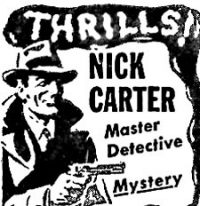
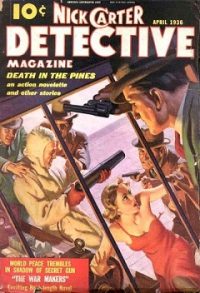 Nick Carter, Master Detective (1943-1955) aired “Corpse in the Cab” on February 5, 1944. This is the 15th Nick Carter episode we’ve run since 2009, the last being August of 2020. Carter’s history is long, covers numerous media, and is one of the more fascinating we’ve come upon. To crib from one of our earlier entries for new listeners, and slightly tweaked with new material, Nick Carter on radio ran a respectable twelve years, from 1943-1955, but the famous detective’s history begins much earlier. During the post-Civil War era known as Reconstruction, a short story featuring Carter appeared in an obscure fiction paper (The New York Weekly) in 1886 (predating the first Sherlock Holmes story by two years). The publisher was none other than Street & Smith, a fledgling, struggling publishing firm which would later become the most dominant pulp magazine publisher in the world. Among its later titles would be Astounding Science Fiction (now Analog), the only magazine from Street & Smith to survive the pulp magazine crash of the 1950s.
Nick Carter, Master Detective (1943-1955) aired “Corpse in the Cab” on February 5, 1944. This is the 15th Nick Carter episode we’ve run since 2009, the last being August of 2020. Carter’s history is long, covers numerous media, and is one of the more fascinating we’ve come upon. To crib from one of our earlier entries for new listeners, and slightly tweaked with new material, Nick Carter on radio ran a respectable twelve years, from 1943-1955, but the famous detective’s history begins much earlier. During the post-Civil War era known as Reconstruction, a short story featuring Carter appeared in an obscure fiction paper (The New York Weekly) in 1886 (predating the first Sherlock Holmes story by two years). The publisher was none other than Street & Smith, a fledgling, struggling publishing firm which would later become the most dominant pulp magazine publisher in the world. Among its later titles would be Astounding Science Fiction (now Analog), the only magazine from Street & Smith to survive the pulp magazine crash of the 1950s.
(Top right: Nick Carter Magazine for April 1936)
Award-winning radio historian Elizabeth McLeod notes that, “Within a decade, an ongoing series of Nick Carter novels vaulted [Street & Smith] to the front ranks of dime-novel publishers, and made Nick himself a national institution. Nick’s own magazine, The New Nick Carter Weekly, would carry the detective into the twentieth-century.” By 1915, however, the then titled Nick Carter Weekly became Street and Smith’s Detective Story Magazine, a true pulp magazine and S&S’s initial entry into this new format. Again, from Elizabeth McLeod: “Detective Story Weekly soon became Street and Smith’s flagship publication. With the rise of radio in the 1920s, it became the firm’s entree into the broadcast medium. The Street and Smith Detective Story Hour became a favorite of listeners at decade’s end, with elaborate tales of murder and crime hosted by a mysterious narrator introduced only as “The Shadow.” While Nick Carter himself did not appear on the program, his spirit was very much in evidence in the various detective characters that populated the stories.” Of course, we all know what happened next. The mysterious voice only introducing the S&S Detective Story Hour became so popular that S&S launched The Shadow magazine in 1931, and shortly thereafter S&S added Doc Savage to its pulp adventure line. Amidst all of this activity Nick Carter was even given his own magazine (again) in 1933, proving the character’s resiliency and staying power–he was now 47 years old.
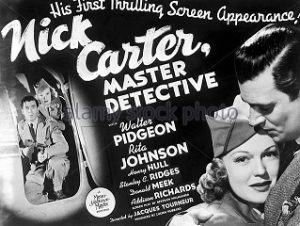
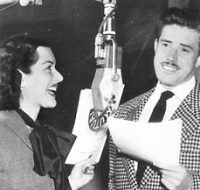 Nick Carter Magazine ran for 40 issues, from March 1933 to June 1936, the final six issues slightly retitled as Nick Carter Detective Magazine. While the magazine had folded, its long-running character still lived, for in 1939 Hollywood picked up the movie rights and produced three “B” Carter films starring noted actor Walter Pidgeon* (who later would star in the classic 1956 SF film Forbidden Planet). A mere three years later, Nick Carter would rise from the dead yet again in his own radio series, Nick Carter, Master Detective. The show’s producer and often the writer, Sherman “Jock” MacGregor, would enlist some of the best writers in the business to script Carter’s episodes, including Robert Arthur and David Kogan of Mysterious Traveler fame, the creator of The Shadow, Walter Gibson, and none other than legendary SF author Alfred Bester (one of which Bester-written episodes, “Chemical Chickens,” we ran in March of 2014 here). Lon Clark played Nick Carter throughout its 12-year run, ably supported by first Helen Choate until mid-1946 (photo above right with Lon Clark) and then Charlotte Manson as Nick’s intelligent, perky secretary Patsy Bowen. Other mainstay characters included Police Sergeant Matty Mathieson, young newspaper reporter Scubby Wilson, and scruffy old veteran of the crime game Waldo McGlynn.
Nick Carter Magazine ran for 40 issues, from March 1933 to June 1936, the final six issues slightly retitled as Nick Carter Detective Magazine. While the magazine had folded, its long-running character still lived, for in 1939 Hollywood picked up the movie rights and produced three “B” Carter films starring noted actor Walter Pidgeon* (who later would star in the classic 1956 SF film Forbidden Planet). A mere three years later, Nick Carter would rise from the dead yet again in his own radio series, Nick Carter, Master Detective. The show’s producer and often the writer, Sherman “Jock” MacGregor, would enlist some of the best writers in the business to script Carter’s episodes, including Robert Arthur and David Kogan of Mysterious Traveler fame, the creator of The Shadow, Walter Gibson, and none other than legendary SF author Alfred Bester (one of which Bester-written episodes, “Chemical Chickens,” we ran in March of 2014 here). Lon Clark played Nick Carter throughout its 12-year run, ably supported by first Helen Choate until mid-1946 (photo above right with Lon Clark) and then Charlotte Manson as Nick’s intelligent, perky secretary Patsy Bowen. Other mainstay characters included Police Sergeant Matty Mathieson, young newspaper reporter Scubby Wilson, and scruffy old veteran of the crime game Waldo McGlynn.
*(The first of the three Nick Carter films was 1939’s Nick Carter, Master Detective. Of interest to SF genre buffs is that it was directed by Jacques Tourneur, now famous for directing the following trio of Val Lewton horror films: Cat People (1943), I Walked with a Zombie (1943), and The Leopard Man (1943).)
From Nick Carter’s beginnings in 1886 through his final radio show in 1955, Carter would change with the times; from clean-living detective (actually, at the beginning of his career, Nick was a private investigator and consulting detective to the police department, much like Sherlock Holmes, and did not work as a police detective), master of disguise, to anti-espionage agent, to the bane of mad scientists or the defender of scientists beset by crooks, Nick Carter has enjoyed one of the longest surviving, most popular runs in various media for over 100 years, for when his radio show ended in 1955 he would resurface (yet again!) in a series of James Bond-type paperback novels in the 1960s which ran into the 1990s, quite a few of them written by women.
Virtually forgotten today, Nick Carter predates Dashiell Hammett’s Sam Spade, Raymond Chandler’s Philip Marlowe, and was originally inspired by the real-life exploits of private investigator Allan Pinkerton.
“Corpse in the Cab,” as you can see by its broadcast date, aired in the middle of World War II. They say that “All is Fair in Love and War,” and this episode is hard proof of that timeless adage, for how low will traitorous spies go if they trade on the patriotism of school age children to fulfill their treacherous schemes?
Play Time: 29:20
{After listening to this episode of Nick Carter, one of their favorite detective programs, the neighborhood gang headed for the corner newsstand to purchase more tales of dangerous skullduggery. Crack Detective Stories (1938-57), as mentioned in previous episode notes, went through a total of 8 title changes in its 20 year history. From 1943 to 1949 it stuck with the title on the cover below. It was a bi-monthly in 1944. Detective Tales (1935-53), though popular enough to enjoy an impressive publishing history even through the dark days of the War and never skipping one of it monthly issues, until 1951, nevertheless shared its fate with many another pulp magazine forced to close shop in the wake of the early 1950s pulp magazine massacre. It was a monthly in 1944. G-Men Detective (1935-53) hit it big during the interest in the various “agent” radio, film and magazine years of the 1930s. Like other genre pulps of the War War II years it ran its share of war- and espionage-themed stories as the cover below shows. It was a monthly until early 1940 then vacillated between bi-monthly and quarterly schedules until 1951 when it saw only two quarterly issues published. It then managed but two more issues before giving up the ghost, one each for both 1952 and 1953. It was a quarterly in 1944.]
[Left: Crack Det., Mar. 1944 – Center: Det. Tales, Feb. 1944 – Right: G-Men Det., Winter 1944]
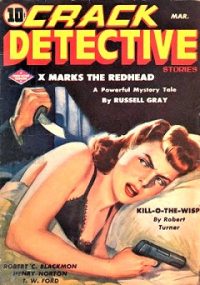
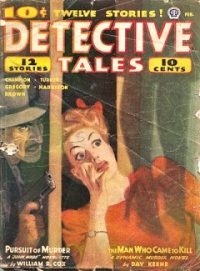
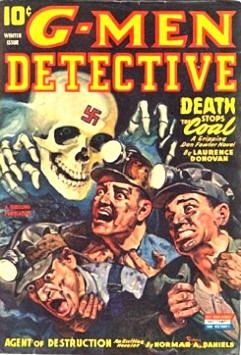
To view the entire list of weekly Old Time Radio episodes at Tangent Online, click here.